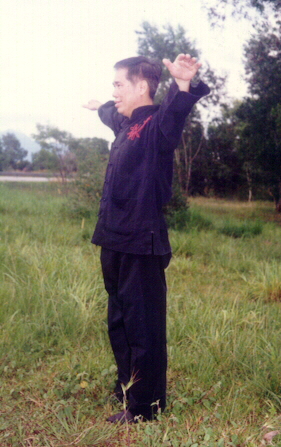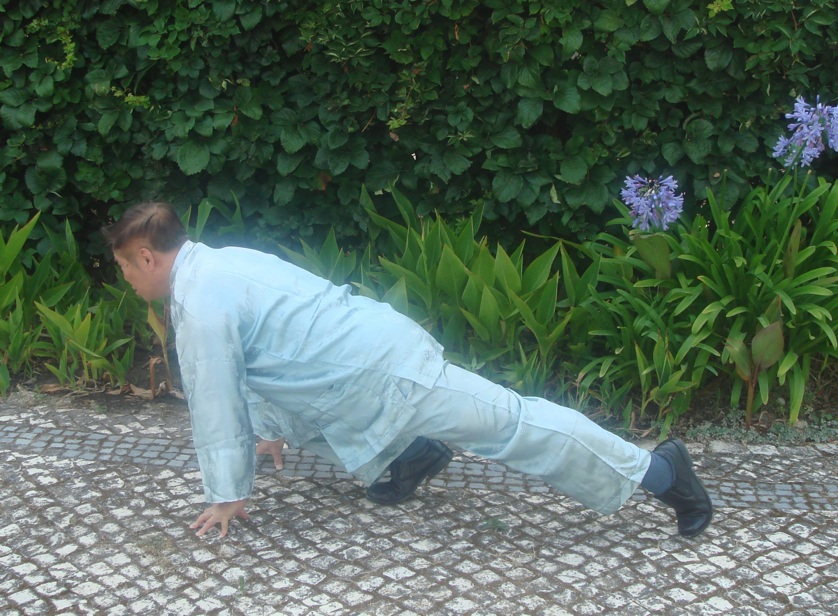IS THERE ANY RELATION BETWEEN FIVE-ANIMAL PLAY AND OUR CHI FLOW?

"Soft" Chi Kung
Question
Is there any relation between the "5-Animal Play Chi Kung" and our "Chi Flow"? If so, in which way the 5-Animal Play has contributed to the Chi Kung that is practiced in our School?
Santiago
Answer
As in many chi kung questions, depending on our point of reference, the answer can be “yes” or “no”. Further, the answer will also depend on what we mean by “chi flow”.
If our point of reference is historical, and by chi flow we mean what the term literally describes, there is no relation between Five-Animal Play and our Shaolin Cosmos Chi Kung which, of course, generates a chi flow.
Five-Animal Play was invented by the great physician, Hua Tuo, who lived in the 2nd century. It was classified as medical chi kung. Shaolin Cosmos Chi Kung developed in the Shaolin Temple, which was established in the 6th century, about 400 years later, and it was classified as martial art chi kung. There is, therefore, no relation in the historical development of our chi kung, which has chi flow, and Five-Animal Play.
Medical chi kung was regarded as “soft”, and was mainly employed for overcoming pain and illness. Interestingly, soft medical chi kung, like the Five-Animal Play, was generally described as external art, or wai gong. Martial art chi kung was regarded as “hard”, and was mainly employed for enhancing combat efficiency. Hard martial art chi kung, like Sinew Metamorphosis, was generally described as internal art, or nei gong.
Hence, from the perspective of their nature, characteristic and function, there is no relation between our chi kung, which has chi flow, and Five-animal Play. Our chi kung, Shaolin Cosmos Chi Kung, is hard, internal and martial. Five-Animal Play is soft, external and medical. They have opposite features.
However, if we look at the historical development as well as the nature, characteristic and function not of Shaolin Cosmos Chi Kung as a whole, but at the chi kung practiced in our school, which is still called Shaolin Cosmos Chi Kung, we can answer yes, there is a relation between the Five-Animal Play and our chi flow.
Initially, external chi flow movements in our school were little, if at all. Much of the chi kung I originally taught in our school came from Sifu Ho Fatt Nam. My sifu, Sifu Ho Fatt Nam, did not encourage vigorous chi flow movements. Sometimes, there were some slight external chi flow movements, which were poetically described as “Flowing Breeze Swaying Willows”.
But undoubtedly there were a lot of internal chi flow movements. I could clearly felt internal chi flow when practicing One-Finger Shooting Zen and Small Universe. Even in external exercise like Thirty Punches, I could feel a lot of internal chi flow. But we did not call it chi flow, we called it internal force.
Chi flow, in the sense of self-manifested chi movement, became obvious when I started teaching chi kung to the public. In my early chi kung classes in Penang in the 1980s, for example, students moved about in vigorous external chi flow movements. A student, called Percy, hopped for about 15 minutes like a kangaroo. Soon he told me that his arthritis, or rheumatism as I cannot remember exactly, was overcome. Another student, whose name I cannot remember, suddenly put his hands onto his head with fingers pointed like antlers and ran about like a deer. In later classes, students wriggled about like snakes, and jumped about like monkeys.
These external chi flow movements developed independently before I read about Five-Animal Play. At that time I had no idea chi flow was the ingredient that overcame pain and illness. Like most chi kung masters, I thought my students overcame their illness because of the chi kung exercises I taught them.
Around this time there was talk about self-manifested chi movement from China. A world famous chi kung master, Sifu Yan Xin from China, transmitted chi to hundreds of students by merely talking in lectures, with the result that the audience went into self-manifested chi flow movement, and later recovered from various diseases. I could relate this self-manifested chi movement to the external chi flow movement of my students in my early chi kung classes.
Then I read more about Five-Animal Play and came to a conclusion that what was called Five-Animal Play in the past was called self-manifested chi movement in the present. Years ago, I had read about Five-Animal Play by Hua Tuo, but at that time I thought Hua Tuo imitated the movements of five different animals and taught the animal movements to his patients. The concept of Five-Animal Play from what I read was low level chi kung at a physical level.
Five-Animal Play and self-manifested chi movement were given a boost in my teaching when a chi kung master from Alor Star worked for Advanced Service in Sungai Petani founded by me and two other partners. He taught Soaring Crane Chi Kung which led to self-manifested chi movement. Later this master betrayed me and left, but vigorous external chi flow movement became increasingly important in my teaching. The emphasis of my chi kung teaching also gradually changed from enhancing martial arts to overcoming illness and contributing to good health, vitality and longevity.
At first I called these vigorous external chi flow movements induced chi flow. But when Douglas, my most senior student in the West, commented that other types of our chi kung, like Eighteen Lohan Hands and One-finger Shooting Zen, also induced chi flow, I changed the term to self-manifested chi movement.
Hence, it can be seen that Five-Animal Play has played a vital role in the development of our chi kung, including our concept and practice of chi flow. In the process, it has contributed greatly to both the philosophy and practice of our chi kung training, including in our various kungfu styles.
At the beginning our chi kung was hard and martial, and we called our chi flow internal force. With the influence of Five-Animal Play and its modern equivalent of self-manifested chi movement, while maintaining its hard and martial features, our chi kung has become more flowing, even in our kungfu training, to the extent that some people wonder why our Shaolin Kungfu is not hard and external.
We also have gradually shifted our emphasis from combat efficiency to first overcoming illness and maintaining good health, next to vitality and longevity, and eventually to peak performance and spiritual joys.
Our chi flow, much influenced by Five-Animal Play and self-manifested chi movement, has made us ridiculously cost-effective. We can achieve in months what even past masters took years to achieve.
Our development led us to our understanding that it is chi flow, and not the chi kung exercises, that enables practitioners to overcome pain and illness, and to contribute to good health, vitality, longevity, mental freshness and spiritual joys. In kungfu training, we also understand that it is chi flow, not the exercises themselves, that enables us to develop internal force, which in turn maintains life, enhances life and enables us to have better results no matter what we do!
Chi flow has become a hallmark of our school. As Tim Franklin rightly pointed out, people in future would identify our school by our unique characteristic of chi flow. Five-Animal Play has contributed much to these wonderful benefits of the chi kung practiced in our school.
The questions and answers are reproduced from the thread Hua Tuo’s Five-Animal Play - 10 Questions to Grandmaster in the Shaolin Wahnam Discussion Forum.

"Hard" Chi KUng
LINKS
